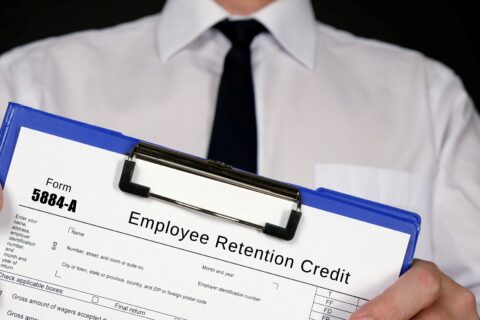The rapidly-changing regulatory environment and what this means for physician practices
COVID-19 has changed the way physicians practice medicine. The CARES Act has put forth many provisions for healthcare practitioners to survive. The Trump administration has issued temporary regulations and waivers along with new rules so that our health system can respond to the pandemic. This alert discusses some of the provisions of the CARES Act and guidance issued by the Centers for Medicare and Medicaid Services (CMS) that can benefit physician practices.
Payroll Benefits
Physician practices have laid off or furloughed many employees, especially those who perform elective procedures. To defray the cost of paying employees even when they are unable to work, the CARES Act includes the Employee Retention Tax Credit. The Employee Retention Tax Credit reimburses eligible employers through a refundable payroll tax credit equal to 50% of covered wages (including employer costs for health insurance) up to $10,000 paid from March 13 to Dec. 31, 2020.
The credit is available for an employer[1] whose operations have been partially or fully interrupted on account of a government order that limits commerce, travel or group meetings (for commercial, social, religious or other purposes) due to COVID-19 or whose gross receipts for the 2020 calendar quarter have decreased more than 50% when compared to the same quarter in 2019.
If eligibility for the credit is determined based on the gross receipts test, than eligibility continues until the gross receipts for the 2020 quarter recover to 80%, when compared to the same 2019 quarter. Employers with more than 100 full-time equivalent employees will only have covered wages for hours not worked by their employees. Employers with 100 or fewer employees will be able to treat all wages paid as covered. Businesses that receive a loan through the SBA’s Paycheck Protection Program (PPP) described below are not eligible for the credit.
The credit payment is delivered to the employer through an offset of federal payroll tax deposits, including amounts withheld from employees, that would otherwise be due to the IRS each pay period. Alternatively, a refund request can be made by filing Form 7200. The payroll tax liabilities and the advanced payments via credits will be reconciled on each quarter’s Form 941, Quarterly Payroll Tax Return.
Another opportunity to improve short term cash flow is the deferral of the remaining 2020 employer Social Security tax (6.2% of wage payments up to the Social Security wage limit) payments, with 50% due by the end of 2021 and 50% due by the end of 2022.
Loan Programs
The PPP is a loan program to help cover payroll costs, including healthcare and retirement costs, rent, mortgage interest and utility payments.
Loans used to pay salaries are capped at $100,000. The program is available to businesses with 500 or fewer employees. Self-employed individuals can apply for a PPP loan, but partners cannot (although their income can be included in the partnership’s PPP loan application). The maximum loan is the lesser of $10,000,000 or 2.5 times the prior 12 months’ average payroll. PPP loans are for two years, with a 1% interest rate. The PPP allows for full or partial loan forgiveness if the PPP loan proceeds are used during the eight-week period after the PPP loan is funded for eligible expenses, including rehiring laid-off employees and restoring compensation (including owner-employee compensation). To qualify for loan forgiveness, at least 75% of the loan proceeds must be used for compensation, including certain employee benefits, for employees (including self-employed individuals). Setting up a separate bank account for the loan proceeds may facilitate easier tracking of their use.
On April 24, 2020, the President signed the Payroll Protection Program & Healthcare Enhancement Act. An additional $310 billion is provided for PPP.
Eligibility guidance was also updated by the Treasury in issuing the fourth interim and final rule clarifying:
- Hedge funds & private equity firms are ineligible for PPP loans and were generally excluded from Section 7(a) SBA regulations.
- Private equity portfolio companies must apply the SBA affiliation rules as set in 13 CFR 121.301(f) to determine if they exceed the 500 employee limit requirements of the PPP.
- Borrowers should carefully review the certification of the PPP application that the current economic uncertainty makes the loan necessary to support ongoing operations.
- State or local government owned hospitals will not be deemed ineligible to receive PPP loans so long as the hospital receives less than 50% of its funding from state and local government sources exclusive of Medicaid.
- Participation in an Employee Stock Ownership Plan will not trigger affiliation rules.
- Businesses currently in a bankruptcy proceeding or that submit an application for bankruptcy anytime before the loan is disbursed will be ineligible for the PPP loan.
The Economic Injury Disaster Loan (EIDL) program can be used for COVID-19 related sick pay, payroll and operating expenses. This program is available to businesses with 500 or fewer employees. The maximum amount of funds that can be loaned to a single employer is $2,000,000, with maximum interest rates of 3.75% (2.75% for non-profits) and terms up to 30 years. The EIDL program will provide an advance of $10,000 within days upon successful application. The loan advance does not have to be repaid.
Note: Updated April 27, 2020
$60 billion has also been provided for the Economic Injury Disaster Loan program of which $10 billion is allocated for grants and $50 billion for loans.
To the extent permitted under the state corporate practice of medicine rules, many physician practices are portfolio companies of private equity firms. The Small Business Administration (SBA) has broad affiliation rules that can cause a physician practice portfolio company to be an affiliate and aggregated with the other portfolio companies of the private equity firm, likely exceeding the 500-employee requirement of the PPP and EIDL programs. A careful review of the SBA’s affiliation regulations and consultation with counsel should take place before applying for these loans.
Telehealth
For physicians and healthcare practitioners who provide telehealth services, the CMS has added additional current procedural terminology (CPT) codes so that patients, under this public health emergency, can receive Medicare telehealth nationwide. Organizations can provide telehealth services to new or established patients, and providers can waive Medicare copayments.
The CARES Act provides for a $200 million allocation for the expansion of telehealth. The allocation will assist in the purchase of associated equipment.
CMS has provided a temporary waiver of the Medicare and Medicaid requirements that physician and nonphysician practitioners provide services in the state in which they are licensed. CMS waives the Medicare requirement that the physician or provider must be licensed in the state in which they are practicing as long as they meet four conditions laid out in the CMS guidance for Physicians & Other Clinicians.
Tax Incentives in CARES Act
The CARES Act has provided significant business income tax provisions with a goal of putting money back into the economy to assist businesses, including healthcare providers. Below is a summary of some of the more significant provisions:
- The charitable contribution limitation for corporations was increased.
- The cash contribution limitation was increased for 2020 from 10% to 25% of a corporation’s taxable income.
- The CARES Act increases the limitation on contribution of food inventory from 15% to 25% of taxable income.
The Tax Cuts & Jobs Act of 2017 (TCJA) limited non-corporate taxpayers from taking a current deduction of net business losses in excess of a threshold amount against other income. The limitation was for the calendar years beginning after 2017 and before 2026. In 2018, the threshold amount was $500,000 for married filing joint taxpayers, $250,000 for other taxpayers, and was indexed for inflation in future years. The CARES Act suspends the application of this excess business loss rule in 2020, and retroactively suspends the excess business loss limitation rule for 2018 and 2019; however, the basis, at risk, and passive activity loss limitations still apply.
Net operating losses (NOL) under the CARES Act have a five-year carryback for losses incurred after Dec. 31, 2017, and before Jan. 1, 2021. Taxpayers can make an irrevocable election to forego the carryback. The 80% limitation on the NOL deduction arising in years after Dec. 31, 2017, enacted under the TCJA, has been postponed to years beginning after Dec. 31, 2020. Prior to 2018, the highest federal corporate income tax rate was 35%. It may be advantageous to carry any NOL back to the years in which a higher federal corporate income tax rate was in effect.
Business interest expense deduction limitations were amended for 2019 and 2020. The limitation on the deduction of business interest expense increased from 30% to 50% of adjusted taxable income (ATI). For any tax year beginning in 2020, taxpayers may use their 2019 ATI in calculating the 2020 business interest deduction limitation. This is significant as many businesses will be adversely affected as a result of the slowing economy in 2020 and will likely have a lower adjustable taxable income.
For partnerships, the increased business interest limitation to 50% will only apply to years beginning in 2020. For tax years beginning in 2019, 50% of any business interest expense allocated to a partner will not be subject to the business interest limitation and will be automatically deductible in tax year 2020. The remaining 50% will be subject to the limitation regulations.
The CARES Act corrected an error in the drafting of the TCJA, which stated that qualified improvement property placed in service after Jan. 1, 2018 is classified as a 39-year property and therefore not eligible for 100% bonus depreciation. Through the technical correction, qualified improvement property made by a taxpayer is now classified as a 15-year property so taxpayers can take advantage of the 100% bonus depreciation if all other requirements of section 168(k) are met. The change is retroactive to Jan. 1, 2018. Taxpayers may want to consider amending their 2018 tax returns or filing a Form 3115. If the amended return results in a loss, taxpayers may want to carry the loss back to a year in which federal income tax rates were higher. Alternatively, in lieu of an amended return, taxpayers may wish to file an automatic consent Form 3115, Application for Change in Accounting Method, with the timely filed (including extensions) federal income tax return to catch up the missed bonus depreciation.
The corporate AMT tax credit will be completely refundable for tax years beginning after Dec. 31, 2018. The credit may also be taken for tax years beginning after Dec. 31, 2017, if an election is made.
Other Helpful Provisions
CMS made other significant changes to assist physicians, including the relaxation of certain Stark provisions, and changes to workforce provisions, and provisions for accelerated and advance payments. These changes are available in the guidance released March 30, 2020.
This piece was last updated on April 27, 2020.
Contact UsThis article originally appeared on BDO USA, LLP’s “bdo.com/insights”
By Spiro Leunes, CPA, Tax Partner, The BDO Center for Healthcare Excellence & Innovation
Copyright © 2020 BDO USA, LLP.
All rights reserved. www.bdo.com
For more information check out HM&M’s COVID-19 Resources page.
HM&M COVID-19 ResourcesLatest News
On June 9, the IRS released Announcement 2022-13, which modifies Notice 2022-3, by revising the optional standard mileage ...
At the tail end of 2021, the Internal Revenue Service (IRS) released new Schedules K-2 and K-3 effective ...
This information is current as of Sunday, November 21, 2021. On Friday, November 19, 2021, after the Congressional ...
HM&M Updates
DALLAS, Dec. 11, 2024 – Springline Advisory, a trailblazing financial and business advisory firm, is proud to announce its partnership ...
Last month, Senior Manager, Pearl Balsara was invited to speak at the 2023 FPA DFW Annual Conference in ...
We are pleased to announce the winners of the 2022 HM&M Excellence Awards. Ronna Beemer, Keith Phillips, and ...









